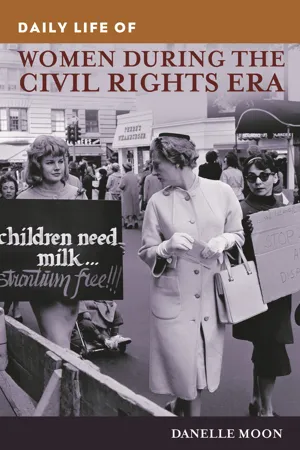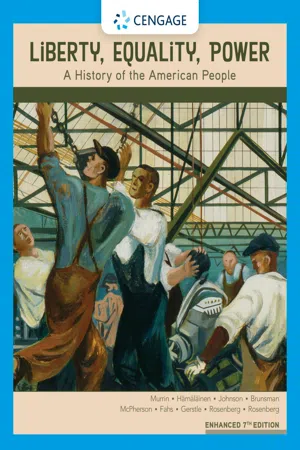History
Women and Progressivism
Women played a significant role in the Progressive Era, advocating for social and political reforms such as suffrage, labor rights, and social welfare. They organized and participated in movements to address issues like child labor, education, and public health. Their activism and advocacy contributed to significant legislative and societal changes, marking a pivotal period in the advancement of women's rights and social progress.
Written by Perlego with AI-assistance
Related key terms
1 of 5
6 Key excerpts on "Women and Progressivism"
- Danelle Moon(Author)
- 2011(Publication Date)
- Greenwood(Publisher)
This chapter will focus on women’s reform during the period known as the Progressive Era, from the late 1880s through 1930. As we shall see, women played a significant role in this era of reform, which spanned the years from 1880 to 1930. The variety of reform that took place can be framed around the continued struggle for women’s rights and specifically the 20th-century suffrage move- ment. From 1901 to 1920, more than 2 million women demanded national voting rights. These women fought side-by-side with progressive reformers to improve American society. Some women worked to create protective labor laws for women and children, influenced public policy in labor employment, birth control rights, while others fought to end racial discrimination and address the lynching crisis of African Americans in the South. Historians writ- ing about women’s history have used the wave metaphor to repre- sent the eruptions of activism across time. WAVES OF FEMINISM Historians have used the metaphor of waves to describe the com- plex history of women’s rights and feminist activism. The first wave refers to the activism that began with the Seneca Falls Convention in 1848 through 1920, when women finally were granted federal voting rights under the Nineteenth Amendment. The second-wave 2 WOMEN AND REFORM IN THE PROGRESSIVE ERA, 1880s TO 1930 22 Daily Life of Women during the Civil Rights Era generation includes women who were active in the postwar years and younger women who came of age during the 1950s and 1960s. French historian and feminist Karen Offen in her exploration of international feminism across time writes that “. . . many ‘waves’ and ‘eruptions’ many ‘feminisms’—can be identified.” 1 She traces back the emergence of the use of the wave metaphor to 1884 when Irish activist Frances Power Cobbe, writing about social move- ments, applied the metaphor of oceans, waves, and tides to ex- press the movement of women.- eBook - PDF
- Paul Boyer, Clifford Clark, Karen Halttunen, Joseph Kett(Authors)
- 2017(Publication Date)
- Cengage Learning EMEA(Publisher)
Women’s clubs embraced reform. Intellectuals challenged the ideological foundations of a business-dominated social order, and journalists exposed municipal corruption and industrialism’s human toll. Throughout America, activists worked to make government more democratic, improve conditions in cities and factories, and curb corporate power. Historians have grouped all these efforts under a single label: “the progressive movement.” In fact, “progressivism” was less a single movement than a spirit of discontent with the status quo and an exciting sense of new social possibilities. International in scope, this spirit found many outlets and addressed many issues. 21-1.1 The Many Faces of Progressivism Who were the progressives, and what reforms did they pursue? The social changes of the era pro-vide clues to the answers. Along with immigration, a growing middle class transformed U.S. cities. From the men and women of this class—mostly white, native-born Protestants—came many of the progressive movement’s leaders and supporters. From 1900 to 1920, the white-collar workforce jumped from 5.1 million to 10.5 million—more than double the growth rate of the labor force as a whole. This burgeoning white-collar class included corporate executives and small-business owners; secretaries, accountants, and sales clerks; civil engi-neers and people in advertising; and professionals such as lawyers, physicians, and teachers. New pro-fessional groups arose, from the American Associa-tion of University Professors (1915) to the American Association of Advertising Agencies (1917). For many middle-class Americans, membership in a national professional society provided a sense of identity that might earlier have come from neigh-borhood, church, or political party. Ambitious, well educated, and valuing social stability, the members of this new middle class were eager to make their influence felt. For middle-class women, the city offered both opportunities and frustrations. - eBook - ePub
Women's Work and Politics in WWI America
The Munsingwear Family of Minneapolis
- Lars Olsson(Author)
- 2018(Publication Date)
- Palgrave Macmillan(Publisher)
© The Author(s) 2018 Lars Olsson Women's Work and Politics in WWI America https://doi.org/10.1007/978-3-319-90215-9_7Begin Abstract7. Progressivism and Social Work for Women in Minneapolis
End AbstractLars Olsson1(1) Linnaeus University, Kalmar, SwedenLars OlssonGendered Progressivism in the United States
In the late nineteenth century, a Progressive movement was, according to Shelton Stromquist , established “in response to the mounting social crisis […] that was most clearly revealed in the battles between labor and capital in the campaigns to save the wasted lives produced by the industrial growth.” Basically, most Progressives held the idea that capitalism would produce prosperity and relieve misery, and they “banished the language of class from the vocabulary of reform.” Instead, they reinvented the concept of “the people” in order to “include a broad cross-section of Americans irrespective of class ” and to shape social harmony based on the capitalist mode of production . They tried to develop a class-bridging “model of reform pioneered by women on behalf of a gendered , maternalist reform agenda.”1 Their main aim was to “master the ‘labor problem’” in order to reduce the risk of open labor conflicts.2 Reformers demanded “minimum standards of health and safety, housing and employment” so that class antagonism could be bridged and individuals could become “functioning and productive members of society.”3Progressive ideas had their heyday from 1907 to 1914. Thereafter, two different but partly related processes gradually split the consensus of Progressivism. One of these processes implied that “class warfare seemed again to be polarizing society,” challenging the idea of social harmony between the classes. According to Stromquist, “the economic imperatives of war unleashed the most dramatic wave of strikes in American history.” The other process was the prospect of the entry of the United States into the war in Europe, which was on the political agenda from 1915. Until then, the political unity of a multi-ethnic society was the dominant political idea in the United States, but gradually from 1915 and certainly from April 1917, the mobilization for war and national loyalty to an Anglo-American nation overran everything else in US politics, including labor protests. Progressives had to position themselves on both processes.4 In this study, I will highlight four gendered, class-bridging Progressive organizations, which focused on the living conditions of working class women in Minneapolis and were deeply involved in the integration of women workers in the social order of the city: the Women’s Trade Union League (WTUL) , the Women’s Welfare League , the Young Women’s Christian Association (YWCA) , and the settlement houses - eBook - PDF
- Nancy F. Cott(Author)
- 2012(Publication Date)
- De Gruyter Saur(Publisher)
Thus, colonial and early nineteenth-century female reformers directed their activities into channels which were merely an extension of their domestic concerns and traditional roles. They taught school, cared for the poor, the sick, the aged. As their consciousness developed, they turned their attention toward the needs of women. Becoming woman-oriented, they began to uplift prostitutes, organize women for abolition or temperance and sought to upgrade female education, but only in order to equip women better for their traditional roles. Only at a later stage, growing out of the recognition of the separate interests of women as a group, and of their subordinate place in society, did their consciousness become woman-defined. Feminist thought starts at this level and encompasses the active assertion of the rights and grievances of women. These various stages of female consciousness need to be considered in historical analysis. The next level of conceptualizing women's history has been contribution history: describing women's contribution to, their status in, and their oppression by male-defined society. Under this category we find a variety of questions being asked: What have women contributed to abolition, to reform, to the Progressive movement, to the labor movement, to the New Deal? The movement in question stands in the foreground 204 HISTORY OF WOMEN IN THE UNITED STATES of inquiry; women made a contribution to it; the contribution is judged first of all with respect to its effect on that movement and secondly by standards appropriate to men. The ways in which women were aided and affected by the work of these great women, the ways in which they themselves grew into feminist awareness, are ignored. - eBook - PDF
Liberty, Equality, Power
A History of the American People, Enhanced
- John Murrin, Pekka Hämäläinen, Paul Johnson, Denver Brunsman(Authors)
- 2019(Publication Date)
- Cengage Learning EMEA(Publisher)
By the turn of the 20th century, this network was vast and increasingly drawn to the efforts of Jane Addams and other female reformers to 21.4 Florence Kelley A leading progressive reformer, member of Hull House, and Illinois’s first chief factory inspector. Library of Congress Prints and Photographs Division [LC-USZ62-137950] Table 21.1 WOMEN ENROLLED IN INSTITUTIONS OF HIGHER EDUCATION, 1870–1930 Year Women’s Colleges (thousands of students) Coed Institutions (thousands of students) Total (thousands of students) Percentage of All Students Enrolled 1870 6.5 4.6 11.1 21.0% 1880 15.7 23.9 39.6 33.4% 1890 16.8 39.5 56.3 35.9% 1900 24.4 61.0 85.4 36.8% 1910 34.1 106.5 140.6 39.6% 1920 52.9 230.0 282.9 39.6% 1930 82.1 398.7 480.8 43.7% Source : Data in Mabel Newcomer, A Century of Higher Education for American Women (New York: Harper and Row, 1959), p. 46. CHAPTER 21 Progressivism, 1900–1917 578 Although the IWW’s membership at any one time rarely exceeded 20,000, it acquired a national reputation by organizing the poorest and most isolated workers and leading them in strikes against employers who were unaccustomed to having their authority challenged. Violence lurked beneath the surface of these strikes and occasionally erupted in bloody skirmishes between strikers and police, National Guardsmen, or the private security forces hired by employers. Mainstream socialists, led by Debs, shared the IWW’s desire to end capitalism but believed that socialism could be achieved democratically, by electing socialists to office and ultimately to the presidency itself. Progressives often worked hand-in-hand with socialists to win economic and political reforms. Many intellectuals and reformers—including John Dewey, Richard Ely, Thorstein Veblen, and Helen Keller, the leading spokesperson for the disabled—moved back and forth between socialism and progressivism. - eBook - PDF
Activist Scholar
Selected Works of Marilyn Gittell
- Ross Gittell, Kathe Newman, Ross J. Gittell, Kathe Newman(Authors)
- 2011(Publication Date)
- SAGE Publications, Inc(Publisher)
Yet, despite their awareness of the political implications of urban social problems, women in the reform movement shared the male Progressives’ belief that the city’s problems were amenable to non-political solutions of urban and environmental planning. Their con-tinued justification of political participation by the “special sphere” argument was partly a matter of expediency, but it also fit with the concept of rational administration in both household and city dear to all Progressives. Civic reform became to Progressives largely a “scientific” endeavor, analogous to scientific management in the fac-tory. At the same time that women’s special contribution was to some degree publically recognized, their role was being undermined by the increasing professionalization of social service work and the mani-pulation of urban issues by a new generation of civic experts who were primarily men. The ideological legacy of this era has been the 11 Cited in Rothman, p. 117. Chapter 9 Changing Women’s Roles in Political Volunteerism 287 perpetuation of a political analysis of the problems of cities which has insulated government officials from the demands of working-class and minority people. The political energies of Progressive reform, like those of the suffrage movement, were channeled into several directions during the 1920s. The League of Women Voters, for example, continued to lobby for such measures as equal pay, child-labor laws, and regulation of women’s wages and working hours, while the Women’s Party pushed for an Equal Rights Amendment. Many middle-class women entered the burgeoning profession of social work, while working-class women, when politically involved, participated in socialist or trade-union movements. The New Deal period witnessed even more active political partici-pation by women in city issues than the Progressive era.
Index pages curate the most relevant extracts from our library of academic textbooks. They’ve been created using an in-house natural language model (NLM), each adding context and meaning to key research topics.





